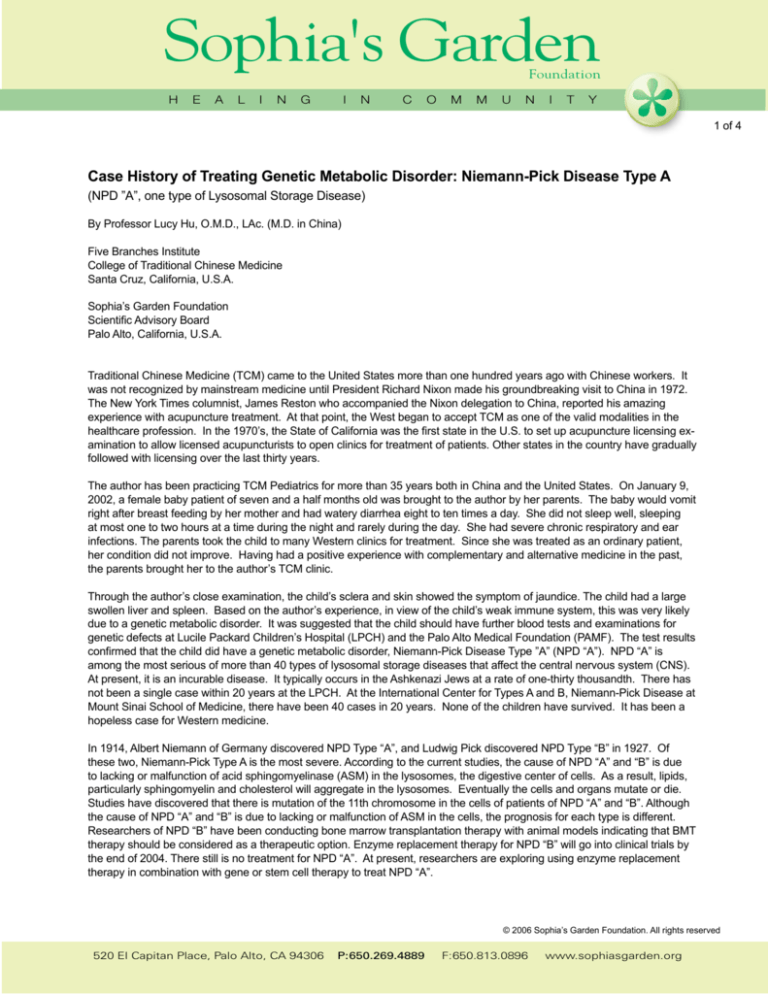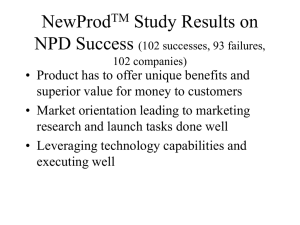
Sophia's Garden
Foundation
H
E
A
L
I
N
G
I
N
C
O
M
M
U
N
I
T
Y
1 of 4
Case History of Treating Genetic Metabolic Disorder: Niemann-Pick Disease Type A
(NPD ”A”, one type of Lysosomal Storage Disease)
By Professor Lucy Hu, O.M.D., LAc. (M.D. in China)
Five Branches Institute
College of Traditional Chinese Medicine
Santa Cruz, California, U.S.A.
Sophia’s Garden Foundation
Scientific Advisory Board
Palo Alto, California, U.S.A.
Traditional Chinese Medicine (TCM) came to the United States more than one hundred years ago with Chinese workers. It
was not recognized by mainstream medicine until President Richard Nixon made his groundbreaking visit to China in 1972.
The New York Times columnist, James Reston who accompanied the Nixon delegation to China, reported his amazing
experience with acupuncture treatment. At that point, the West began to accept TCM as one of the valid modalities in the
healthcare profession. In the 1970’s, the State of California was the first state in the U.S. to set up acupuncture licensing examination to allow licensed acupuncturists to open clinics for treatment of patients. Other states in the country have gradually
followed with licensing over the last thirty years.
The author has been practicing TCM Pediatrics for more than 35 years both in China and the United States. On January 9,
2002, a female baby patient of seven and a half months old was brought to the author by her parents. The baby would vomit
right after breast feeding by her mother and had watery diarrhea eight to ten times a day. She did not sleep well, sleeping
at most one to two hours at a time during the night and rarely during the day. She had severe chronic respiratory and ear
infections. The parents took the child to many Western clinics for treatment. Since she was treated as an ordinary patient,
her condition did not improve. Having had a positive experience with complementary and alternative medicine in the past,
the parents brought her to the author’s TCM clinic.
Through the author’s close examination, the child’s sclera and skin showed the symptom of jaundice. The child had a large
swollen liver and spleen. Based on the author’s experience, in view of the child’s weak immune system, this was very likely
due to a genetic metabolic disorder. It was suggested that the child should have further blood tests and examinations for
genetic defects at Lucile Packard Children’s Hospital (LPCH) and the Palo Alto Medical Foundation (PAMF). The test results
confirmed that the child did have a genetic metabolic disorder, Niemann-Pick Disease Type ”A” (NPD “A”). NPD “A” is
among the most serious of more than 40 types of lysosomal storage diseases that affect the central nervous system (CNS).
At present, it is an incurable disease. It typically occurs in the Ashkenazi Jews at a rate of one-thirty thousandth. There has
not been a single case within 20 years at the LPCH. At the International Center for Types A and B, Niemann-Pick Disease at
Mount Sinai School of Medicine, there have been 40 cases in 20 years. None of the children have survived. It has been a
hopeless case for Western medicine.
In 1914, Albert Niemann of Germany discovered NPD Type “A”, and Ludwig Pick discovered NPD Type “B” in 1927. Of
these two, Niemann-Pick Type A is the most severe. According to the current studies, the cause of NPD “A” and “B” is due
to lacking or malfunction of acid sphingomyelinase (ASM) in the lysosomes, the digestive center of cells. As a result, lipids,
particularly sphingomyelin and cholesterol will aggregate in the lysosomes. Eventually the cells and organs mutate or die.
Studies have discovered that there is mutation of the 11th chromosome in the cells of patients of NPD “A” and “B”. Although
the cause of NPD “A” and “B” is due to lacking or malfunction of ASM in the cells, the prognosis for each type is different.
Researchers of NPD “B” have been conducting bone marrow transplantation therapy with animal models indicating that BMT
therapy should be considered as a therapeutic option. Enzyme replacement therapy for NPD “B” will go into clinical trials by
the end of 2004. There still is no treatment for NPD “A”. At present, researchers are exploring using enzyme replacement
therapy in combination with gene or stem cell therapy to treat NPD “A”.
© 2006 Sophia’s Garden Foundation. All rights reserved
520 El Capitan Place, Palo Alto, CA 94306
P:650.269.4889
F:650.813.0896
www.sophiasgarden.org
Sophia's Garden
Foundation
H
E
A
L
I
N
G
I
N
C
O
M
M
U
N
I
T
Y
2 of 4
The clinical symptoms of NPD “A” are mainly shown as follows:
1.
2.
3.
4.
5.
6.
7.
8.
9.
10.
11.
12.
13.
A chronic jaundice since birth
Abdominal distention
Progressive akinesia
Difficulty in feeding and swallowing
Difficulty in the vertical movement of eyes
Hepatosplenomegaly and hepatocirrhosis
Developmental delay
Sudden loss of muscular tension
Epilepsy
Highly sensitive to touch
Inflammation in the respiratory system and ears, in complication with pneumonia
Breathing only through mouth due to the constant blockage of nose
Normal growth of teeth and bones
The child showed basically all of these symptoms when the author first saw her. The test results reveal that, as the parents
both are Ashkenazi Jews, they carry the autosomal recessive genes of NPD “A” variation and passed one each onto the
child. NPD ”A” has three common genetic mutations accounting for 90% of the cases, namely R496L, L302P, and FSP330.
The child carries one R496L gene and a family, or “wildcard” gene R441X. R441X is a stop-codon mutation that prevents the
formation of complete acid sphingomyelinase (ASM), the enzyme the body requires to breakdown sphingomyelin. The presence of this mutation provides a rare opportunity to treat this disease as drugs have been identified recently that promote
the “read through” of stop-codon mutations. In this case of NPD “A”, the presence of the drug within a cell will restore some
of its ability to form full-length ASM enzyme. This is a new form of treatment that you’ll hear more about in the second talk of
this case study.
When the child first came to the author’s TCM clinic, her condition was very severe. The author began treatment of symptoms while waiting for the results of the blood and genetic tests. The author had to completely rely on the methodology of
TCM, Bian Zheng Lun Zhi (to identify patterns and determine treatment) through protocols of TCM with Chinese herbs and
acupuncture. The child was considered, in Chinese medical terms, having liver-gallbladder damp-heat, liver Qi stagnation,
spleen Qi deficiency, stomach Qi ascending counterflow, and Qi-blood deficiency. Therefore, the author started dispelling
liver-gallbladder damp-heat, fortifying the spleen and soothing the liver. The first step was chiefly using modified Yin Chen
Hao (Herba Artemisia Capillaris) formula and applying acupuncture to dispel jaundice, soothe the liver and fortify the spleen.
Acupuncture points included Liv 3, Du 9, UB 18-20, GB 34 and ST 36. Because of the child’s inability to digest food and
the bitter taste of the herbal formula tea, the herbal formula tea was taken by the mother and passed to the child through
mother’s milk.
After four days:
95% of jaundice was eliminated.
After two weeks: sleeping was improved; watery stool was softer; and the child still had distention with gas.
After three weeks:vomiting was reduced by 90%; and the child still had distention with gas.
After a month:
vomiting had completely disappeared.
Based on the improvement of the child’s clinical condition, the author readjusted the Chinese herbal formula and positions
of acupuncture points, and paid special attention to fortify the spleen, rectify and supplement Qi and soothe and cleanse the
liver. Du 9 and GB 34 points were stopped, and LI 11, ST 25, KI 3 and UB 43 among other points were initiated. Modified Bo
He and Ren Shen Jian Pi formulas were given for the digestive problems and to smooth and detox the liver.
The result of the blood and genetic tests was produced after two and half months of the first visit to the author’s TCM clinic.
The child was diagnosed with NPD “A”. As mentioned earlier, NPD “A” is due to lacking or malfunction of ASM in the cells,
confusing metabolism and causing storage of fat, cholesterol, and other metabolites, which cause cell death. According to
the TCM Bian Zheng Lun Zhi, the author further analyzed and diagnosed the child’s condition as follows: this disease shows
© 2006 Sophia’s Garden Foundation. All rights reserved
520 El Capitan Place, Palo Alto, CA 94306
P:650.269.4889
F:650.813.0896
www.sophiasgarden.org
Sophia's Garden
Foundation
H
E
A
L
I
N
G
I
N
C
O
M
M
U
N
I
T
Y
2 of 4
3
much damp-heat brewing internally, damaging liver-gallbladder, causing liver-gallbladder Qi stagnation, Qi-blood inhibited,
obstruction of static blood, with a long period of heat formation, crimson-red tongue body, vexing heat in the five hearts.
In Western medicine terms, the child had jaundice, hepatosplenomegaly, irritability, anemia, splenomegaly, decreased linear
growth and body weight, sleep apnea, respiratory problems, hypotonia and muscular weakness manifested by feeding
difficulties. Consequently, the author again readjusted the Chinese herbal formula and acupuncture points based on the
main TCM treatment principles: quickening the blood and transforming stasis, soothing the liver and rectifying Qi, and
clearing heat and cooling the blood. Furthermore, since the child’s liver and lipid function tests showed a high level of
liver enzymes, triglycerides and cholesterol, the herbal formula was adjusted to lower triglyceride and cholesterol and
increase liver detoxification.
After three months: the child’s appetite had greatly improved and the child had begun eating soft foods; sleeping could last
for six consecutive hours; soft stool had became more formed; and body weight had increased.
After four months:the child was able to self-feed, eating 70% solid foods in addition to breastfeeding; and had an increased
appetite. Stool had become more formed.
After five months: conditions of the child were further improved; her energy level, mental concentration and appetite had
increased; she was able to vocalize sounds and to sit up by herself. The loss of neurological milestones had decelerated in
many cases, an unheard of outcome in this disorder.
During this time, the parents initiated other forms of complementary and alternative medicine to treat the child. Treatments
included but were not limited to holistic nutrition, Feldenkrais, cranialsacral therapy; chiropractic care; homeopathy; aquatic
and music therapy; Western antibiotic medications from the latest genetic research; Western herbs and prayer. Although the
author is not a practitioner in these fields, the author has observed great benefit from this integrative medicine approach to
the child’s care. Valuable observations and insights were shared among the health care team that furthered diagnosis and
treatment of the child.
In the process of treatment, the child had three severe infections of the respiratory system. The first time was in Spring
of 2002 during the three weeks of out-of-town family vacation. The second time was in the Fall 2002 during a three-week
medical research trip to the East Coast for an evaluation by the International Center for Types A and B, Niemann-Pick
Disease. The third time was in January 2003 prior to a hospitalization for a panic episode. All severe infections were under
control with a Chinese antibiotic herbal formula and acupuncture to clear lung heat, transform phlegm and resolve toxin in
the child’s body.
At 19 months old, the disorder had progressed enough to require an emergency hospitalization. The child had lost the neuromuscular ability to clear her own saliva and swallow food effectively, resulting in a choking episode. Her liver and spleen had
continued to enlarge and had begun to have a significant impact on her digestive system. She was sent home on hospice
with a nasal-gastric feeding system and a projected 1 to 4 week life expectancy. The author visited the child the night that
she returned home from the hospital and began a therapy of a Chinese patented herbal medicine, Dong Fang Gan Kang, to
more aggressively cleanse and tonify the liver. Because of her decreased immunity and risk of infection to her respiratory
system, the author prescribed Dong Chong Xia Cao (Cordyceps Sinensis) to tonify the lungs and kidneys and strengthen the
immune system. LI 7 and TB 5 points were added to the child’s acupuncture protocol. After a few months of care at home,
the child’s condition stabilized, however she started having frequent seizures. The author further introduced a brain herb,
Tien Ma, to clean and tonify the child’s neurological system.
Through weekly application of these herbs, acupuncture and Tuina (massage), at 34 months old, the child consumes a
wide range of liquefied fresh organic foods through an enteral feeding system. She occasionally spits up, and discomfort
or gas after eating has been reduced to acceptable levels. She has a soft to formed stool four to eight times a day. (NPD
“A” patients are typically constipated). Respiratory infections have been absent for the last 15 months, indicating a strong
immune system. Her liver and spleen have been slowly reducing in size. Cholesterol, triglycerides, and other key biochemical indicators have gradually been moving into normal ranges. The child has grown eight teeth and a healthy head of hair, all
good signs of metabolic vitality. Although the child has lost neurological milestones resulting from her condition, she remains
mentally partially acute. The more serious autonomic difficulties typical of her disorder (seizures, choking, and hypersensitivity to pain, sound and light) have been ameliorated to acceptable levels of comfort and safety. The child is gaining weight and
© 2006 Sophia’s Garden Foundation. All rights reserved
520 El Capitan Place, Palo Alto, CA 94306
P:650.269.4889
F:650.813.0896
www.sophiasgarden.org
Sophia's Garden
Foundation
H
E
A
L
I
N
G
I
N
C
O
M
M
U
N
I
T
Y
4 of 4
sleeping 7 to 9 hours a night, briefly awakening once to four times for diaper changes. The child naps once or twice a day for
1 to 2 hours. The TCM treatment principles have continued to be soothing the liver, dispelling the obstruction, fortifying the
spleen and calming the spirit to strengthen the child’s immune capability and to maintain and prolong her life.
NPD “A” is indeed a rare clinical case. It has been attempted and tried by the author to find a way of treatment through
TCM with herbs, acupuncture and Tuina. Treatment was achieved through observation of the child’s clinical symptoms and
application of the Chinese Medicine Theory on the Liver System. According to the Chinese Medicine Theory, physiologically
and pathologically, the function of the Liver System is mainly for regulating the flow of Qi with the special characteristics of
ensuring smooth flow and no obstructions. This plays an important role in three areas:
1. Emotional activities
2. Digestion and Absorption
3. The Flow of Qi and Blood
The child’s clinical symptom was basically showing in the ineffectiveness of the digestive system. The liver system physically includes two organs, namely, liver and gallbladder. The ascent and descent of the spleen-stomach Qi and the bile
secretion are influenced by the liver system. The function of the liver to regulate the smooth flow of Qi is the important
condition. If the liver cannot ensure the smooth flow of Qi, then the liver Qi will move reversely causing “Wood” (Liver) to
restrain “Earth” (Spleen), damaging spleen and stomach. Confusion of ascent and descent of Qi may present symptoms as
vomiting, abdominal distention or diarrhea.
The liver has the functions of storing and regulating the blood. During sleep the body and organs need a relatively small
amount of blood flow. When the body is active, the body and organs demand more blood flow. The blood is emanated from
the liver. If the liver’s function of storing blood becomes abnormal, it will cause various sicknesses. In the case of liver-blood
deficiency, it may cause blurred vision, spasm of muscles and tendon problems, and motor impairment.
According to the Chinese Medicine Theory, the liver also dominates the tendons, which means the fasciae depend on the
liver blood for nourishment. Tendons and fasciae are types of tissues which link joints and muscles, and control movement.
If the liver blood is deficient, the tendons will lack nourishment. This will manifest with numbness, tremor or impaired movement of limbs. The child showed early progressive akinesia and sudden loss of muscular tension. This is related to the liver
which could not store the blood and could not nourish the tendons.
The eye is the window of the liver. The essential Qi of the viscera ascends to the eyes. The eyes and the viscera have
a close internal relationship. This is because the liver stores the blood and the liver meridian connects to the eyes. As a
result, the state of the liver is often manifested in the eyes. For good and effective vision, the eyes need the nourishment of
the liver blood. The child’s abnormal eye movement is due to deficiency of the liver blood.
The author has attempted to apply Chinese Medicine Theory to the symptoms and treatment of NPD “A”. At present, NPD
“A” is still considered incurable by Western Medicine. But the positive responses of the child to the treatment have given us
great encouragement and confidence in Traditional Chinese Medicine, the new age medicine yet more than three thousand
years old.
© 2006 Sophia’s Garden Foundation. All rights reserved
520 El Capitan Place, Palo Alto, CA 94306
P:650.269.4889
F:650.813.0896
www.sophiasgarden.org








